The Application of Structural Adhesives in Glulam Beams: A Comparative Study
Abstract
1. Introduction
2. Materials and Methods
2.1. Materials
2.2. Adhesives Characterization
2.3. Lamella Preparation and Assembly of Glulam Beams
2.4. The Shear at the Glue Line and Wood Failure
2.5. Measurement of Glue Line Thickness Through Photomicrography
2.6. Delamination
2.7. X-Ray Densitometry
2.8. Perforation Resistance
2.9. Statistical Analysis
3. Results and Discussion
3.1. Adhesive Caracterization
3.2. Shear Strength in Bond Lines and Wood Failure
3.3. Measurement of Adhesive Bond Line Thickness
3.4. Delamination
3.5. X-Ray Microdensitometry and Drilling Resistance
4. Conclusions
Author Contributions
Funding
Data Availability Statement
Acknowledgments
Conflicts of Interest
Abbreviations
| Glulam | Glued laminated timber |
| MUF | Melamine–urea–formaldehyde |
| RF | Resorcinol–formaldehyde |
| PUR | Polyurethane |
| MOE | Modulus of elasticity |
| Fv0 | Shear strength in the bond line |
| PVA | Polyvinyl acetate |
| S | Upper lamella |
| I | Lower lamella |
References
- Glavinic, I.U.; Boko, I.; Toric, N.; Vrankovic, J.L. Application of Hardwood for Glued Laminated Timber in Europe. J. Croat. Assoc. Civ. Enginners 2020, 72, 607–616. [Google Scholar] [CrossRef]
- Morin-Bernard, A.; Blanchet, P.; Dagenais, C.; Achim, A. Use of Northern Hardwoods in Glued-Laminated Timber: A Study of Bondline Shear Strength and Resistance to Moisture. Eur. J. Wood Wood Prod. 2020, 78, 891–903. [Google Scholar] [CrossRef]
- Adhikari, S.; Quesada, H.; Bond, B.; Hammett, T. Potential of Hardwood Lumber in Cross Laminated Timber in North America: A CLT Manufacturer’s Perspective. Mass Timber Constr. J. 2020, 3, 1–9. [Google Scholar]
- Espinoza, O.; Buehlmann, U. Cross-Laminated Timber in the USA: Opportunity for Hardwoods? Curr. For. Rep. 2018, 4, 1–12. [Google Scholar] [CrossRef]
- Hänsel, A.; Sandak, J.; Sandak, A.; Mai, J.; Niemz, P. Selected Previous Findings on the Factors Influencing the Gluing Quality of Solid Wood Products in Timber Construction and Possible Developments: A Review. Wood Mater. Sci. Eng. 2022, 17, 230–241. [Google Scholar] [CrossRef]
- Balboni, B.M.; Wessels, C.B.; Ribeiro, M.L.; Garcia, J.N. Investigating the Use of Bow for Prestressing Lamellas of Glulam Beams Made with Young Eucalyptus grandis Timber. Constr. Build. Mater. 2023, 362, 129725. [Google Scholar] [CrossRef]
- Seng Hua, L.; Wei Chen, L.; Antov, P.; Kristak, L.; Md Tahir, P. Engineering Wood Products from Eucalyptus spp. Adv. Mater. Sci. Eng. 2022, 2022, 8000780. [Google Scholar] [CrossRef]
- Lara-Bocanegra, A.J.; Majano-Majano, A.; Arriaga, F.; Guaita, M. Eucalyptus globulus Finger Jointed Solid Timber and Glued Laminated Timber with Superior Mechanical Properties: Characterisation and Application in Strained Gridshells. Constr. Build. Mater. 2020, 265, 120355. [Google Scholar] [CrossRef]
- Oliveira, R.G.E.; Gonçalves, F.G.; Segundinho, P.G.A.; Oliveira, J.T.S.; Paes, J.B.; Chaves, I.L.S.; Brito, A.S. Analysis of Glue Line and Correlations between Density and Anatomical Characteristics of Eucalyptus grandis × Eucalyptus urophylla Glulam. Maderas. Cienc. Tecnol. 2020, 22, 495–504. [Google Scholar] [CrossRef]
- Moya, L.; Pérez Gomar, C.; Vega, A.; Sánchez, A.; Torino, I.; Baño, V. Relación Entre Parámetros de Producción y Propiedades Estructurales de Madera Laminada Encolada de Eucalyptus grandis. Maderas. Cienc. Tecnol. 2019, 21, 327–340. [Google Scholar] [CrossRef]
- Dietsch, P.; Tannert, T. Assessing the Integrity of Glued-Laminated Timber Elements. Constr. Build. Mater. 2015, 101, 1259–1270. [Google Scholar] [CrossRef]
- Bukhari, M.D.; Gohar, G.A.; Akhtar, A.; Ullah, S.; Akram, M.; Abid, J.; Raza, H. Adhesion Theories and Effect of Surface Roughness on Energy Estimation and Wettability of Polymeric Composites Bonded Joints: A-Review. VW Appl. Sci. 2019, 2, 74–86. [Google Scholar] [CrossRef]
- Segundinho, P.G.d.A.; Lopes, N.F.; Gonçalves, F.G.; Oliveira, R.F.; Oliveira, R.G.E.; Silva Oliveira, J.T.; da Mastela, L.C.; Belumat, M.A.R.; Paes, J.B. Analysis of Physical and Mechanical Properties of Glued Laminated Timber Elements Produced from Eucalyptus Residues. J. Indian Acad. Wood Sci. 2024, 21, 371–378. [Google Scholar] [CrossRef]
- Leggate, W.; McGavin, R.L.; Outhwaite, A.; Gilbert, B.P.; Gunalan, S. Barriers to the Effective Adhesion of High-Density Hardwood Timbers for Glue-Laminated Beams in Australia. Forests 2022, 13, 1038. [Google Scholar] [CrossRef]
- Acosta, A.P.; de Avila Delucis, R.; Santos, O.L.; Amico, S.C. A Review on Wood Permeability: Influential Factors and Measurement Technologies. J. Indian Acad. Wood Sci. 2024, 21, 175–191. [Google Scholar] [CrossRef]
- Quintilhan, M.T.; Oliveira, W.C.; Oliveira, A.C.; Luísa, B.; Pereira, C.; Môra, R. Physical properties and preservative treatment of Eucalyptus and Corymbia wood. Floresta 2021, 51, 410–418. [Google Scholar] [CrossRef]
- Moreira, G.G.; Hakamada, R.; Silva, R.M.L.d.; de Lemos, C.C.Z.; Florentino, A.L.; Gonçalves, J.L.d.M. Seedling Morphological Characteristics on Survival, Uniformity, and Growth during a Full Short Rotation in Eucalyptus grandis × E. urophylla Plantation. Forests 2023, 14, 1756. [Google Scholar] [CrossRef]
- Rindler, A.; Hansmann, C.; Konnerth, J. The Effect of Moisture on the Mechanical Response of Wood, Adhesive and Their Interphase by Means of Nanoindentation. Wood Sci. Technol. 2019, 53, 729–746. [Google Scholar] [CrossRef]
- Setter, C.; Zidanes, U.L.; Miranda, E.H.N.; Brito, F.M.S.; Mendes, L.M.; Junior, J.B.G. Influence of Wood Species and Adhesive Type on the Performance of Multilaminated Plywood. Environ. Sci. Pollut. Res. 2021, 28, 50835–50846. [Google Scholar] [CrossRef]
- Toumpanaki, E.; Shah, D.U.; Eichhorn, S.J. Beyond What Meets the Eye: Imaging and Imagining Wood Mechanical–Structural Properties. Adv. Mater. 2021, 33, 2001613. [Google Scholar] [CrossRef]
- Nkeuwa, W.N.; Zhang, J.; Semple, K.E.; Chen, M.; Xia, Y.; Dai, C. Bamboo-Based Composites: A Review on Fundamentals and Processes of Bamboo Bonding. Compos. Part B Eng. 2022, 235, 109776. [Google Scholar] [CrossRef]
- Wang, J.; Zhu, R.; Liu, Y.; Zhang, L. Understanding Melt Pool Characteristics in Laser Powder Bed Fusion: An Overview of Single- and Multi-Track Melt Pools for Process Optimization. Adv. Powder Mater. 2023, 2, 100137. [Google Scholar] [CrossRef]
- Raydan, N.D.V.; Leroyer, L.; Charrier, B.; Robles, E. Recent Advances on the Development of Protein-Based Adhesives for Wood Composite Materials—A Review. Molecules 2021, 26, 7617. [Google Scholar] [CrossRef] [PubMed]
- Shirmohammadli, Y.; Pizzi, A.; Raftery, G.M.; Hashemi, A. One-Component Polyurethane Adhesives in Timber Engineering Applications: A Review. Int. J. Adhes. Adhes. 2023, 123, 103358. [Google Scholar] [CrossRef]
- Tai, N.L.; Ghasemlou, M.; Adhikari, R.; Adhikari, B. Starch-Based Isocyanate- and Non-Isocyanate Polyurethane Hybrids: A Review on Synthesis, Performance and Biodegradation. Carbohydr. Polym. 2021, 265, 118029. [Google Scholar] [CrossRef]
- Okada, T.; Kobori, H.; Kojima, Y.; Suzuki, S.; Nishikido, K.; Hirose, A.; Takahashi, K. Evaluating the Durability of Structural Glulam Bonded with Aqueous Polymer-Isocyanate Adhesive by Two Kinds of Accelerated Aging Treatments. Eur. J. Wood Wood Prod. 2020, 78, 113–122. [Google Scholar] [CrossRef]
- Liu, J.; Yue, K.; Xu, L.; Wu, J.; Chen, Z.; Wang, L.; Liu, W.; Lu, W. Bonding Performance of Melamine-Urea–Formaldehyde and Phenol-Resorcinol–Formaldehyde Adhesive Glulams at Elevated Temperatures. Int. J. Adhes. Adhes. 2020, 98, 102500. [Google Scholar] [CrossRef]
- Juhaida, M.F.; Paridah, M.T.; Hilmi, M.M.; Sarani, Z.; Jalaluddin, H.; Mohamad Zaki, A.R. Liquefaction of Kenaf (Hibiscus cannabinus L.) Core for Wood Laminating Adhesive. Bioresour. Technol. 2010, 101, 1355–1360. [Google Scholar] [CrossRef]
- Faria, D.L.; Scatolino, M.V.; Lopes, T.A.; Mesquita Júnior, L.; Mota, G.d.S.; Guimarães Júnior, J.B.; Mendes, L.M.; Soriano, J. Performance of Glulam Beams Produced with Free-Formaldehyde Adhesive and Underexploited Rubber Wood Treated with Preservatives Solutions of Chromated Copper Borate and Pyrethroids. J. Adhes. Sci. Technol. 2020, 34, 1145–1162. [Google Scholar] [CrossRef]
- Bianche, J.J.; Carneiro, A.C.O.; Vital, B.R.; Andrade, B.G.; Gomes, R.M.; Araújo, S.d.O.; Souza, E.C. Improving the Understanding of Wood Bonding: Behavior of Different Adhesives on the Surface of Eucalyptus and Pine Wood. Int. J. Adhes. Adhes. 2022, 112, 102987. [Google Scholar] [CrossRef]
- Paraskar, P.M.; Prabhudesai, M.S.; Hatkar, V.M.; Kulkarni, R.D. Vegetable Oil Based Polyurethane Coatings—A Sustainable Approach: A Review. Prog. Org. Coat. 2021, 156, 156. [Google Scholar] [CrossRef]
- Brunetti, M.; Christovasilis, I.P.; Micheloni, M.; Nocetti, M.; Pizzo, B. Production Feasibility and Performance of Carbon Fibre Reinforced Glulam Beams Manufactured with Polyurethane Adhesive. Compos. B Eng. 2019, 156, 106267. [Google Scholar] [CrossRef]
- Oliveira, R.F.; Segundinho, P.G.d.A.; Silva, J.G.M.; Gonçalves, F.G.; Lopes, D.J.V.; Silva, J.P.M.; Lopes, N.F.; Mastela, L.d.C.; Paes, J.B.; de Souza, C.G.F.; et al. Eucalyptus-Based Glued Laminated Timber: Evaluation and Prediction of Its Properties by Non-Destructive Techniques. Forests 2024, 15, 1658. [Google Scholar] [CrossRef]
- Jeong, B.; Park, B.D.; Causin, V. Influence of Synthesis Method and Melamine Content of Urea-Melamine-Formaldehyde Resins to Their Features in Cohesion, Interphase, and Adhesion Performance. J. Ind. Eng. Chem. 2019, 79, 87–96. [Google Scholar] [CrossRef]
- Park, S.; Jeong, B.; Park, B.D. A Comparison of Adhesion Behavior of Urea-Formaldehyde Resins with Melamine-Urea-Formaldehyde Resins in Bonding Wood. Forests 2021, 12, 1037. [Google Scholar] [CrossRef]
- ASTM D-1084; Standard Test Methods for Viscosity of Adhesives. Annual Book of ASTM Standards. ASTM, American Society of Testing and Materials: West Conshohocken, PA, USA, 2021; pp. 1–16.
- ASTM D1582; Standard Test Method for Nonvolatile Content of Liquid Phenol, Resorcinol, and Melamine Adhesives. Annual Book of ASTM Standards. ASTM, American Society of Testing and Materials: West Conshohocken, PA, USA, 2017.
- ABNT NBR 7190-2:2022; Parte 2: Métodos de Ensaio Para Classificação Visual e Mecânica de Peças Estruturais de Madeira. ABNT, Associação Brasileira de Normas Técnicas: Rio de Janeiro, Brazil, 2022.
- ABNT NBR 7190-6:2022; Projeto de Estruturas de Madeira—Parte 6: Métodos de Ensaio para Caracterização de Madeira Lamelada Colada Estrutural. ABNT, Associação Brasileira de Normas Técnicas: Rio de Janeiro, Brazil, 2022.
- Zangiacomo, A.; Balanco, G.; Christoforo, A.; Lahr, F. Glued Laminated Timber Produced with Tropical Brazilian Wood Species. Curr. J. Appl. Sci. Technol. 2017, 23, 1–12. [Google Scholar] [CrossRef]
- ASTM D905-08; Standard Test Method for Strength Properties of Adhesive Bonds in Shear by Compression Loading. Annual Book of ASTM Standards. ASTM, American Society for Testing and Materials: West Conshohocken, PA, USA, 2021. [CrossRef]
- ASTM D5266-13; Standard Practice for Estimating the Percentage of Wood Failure in Adhesive Bonded Joints. Annual Book of ASTM Standards. ASTM, American Society for Testing and Materials: West Conshohocken, PA, USA, 2020.
- EN 391; Glued Laminated Timber: Delamination Test of Glue Lines. EN, European Committee for Standardization: Brussels, Belgium, 2001.
- Kloppenburg, A.M. Density Determination of Tropical Hardwoods with the Resistograph. Master’s Thesis, Materials Science and Engineering, Delft University of Technology, Delft, The Netherlands, 2018. [Google Scholar]
- Papandrea, S.F.; Cataldo, M.F.; Zimbalatti, G.; Proto, A.R. Comparative Evaluation of Inspection Techniques for Decay Detection in Urban Trees. Sens. Actuators A Phys. 2022, 340, 113544. [Google Scholar] [CrossRef]
- Wu, X.; Li, G.; Jiao, Z.; Wang, X. Reliability of Acoustic Tomography and Ground-Penetrating Radar for Tree Decay Detection. Appl. Plant Sci. 2018, 6, e01187. [Google Scholar] [CrossRef]
- Nowak, T.P.; Jasieńko, J.; Hamrol-Bielecka, K. In Situ Assessment of Structural Timber Using the Resistance Drilling Method—Evaluation of Usefulness. Constr. Build. Mater. 2016, 102, 403–415. [Google Scholar] [CrossRef]
- Nutto, L.; Biechele, T. Drilling Resistance Measurement and the Effect of Shaft Friction—Using Feed Force Information for Improving Decay Identification on Hard Tropical Wood. In Proceedings of the 19th International Nondestructive Testing and Evaluation of Wood Symposium, Rio de Janeiro, Brazil, 22–25 September 2015. [Google Scholar]
- Sharapov, E.; Brischke, C.; Militz, H.; Smirnova, E. Prediction of Modulus of Elasticity in Static Bending and Density of Wood at Different Moisture Contents and Feed Rates by Drilling Resistance Measurements. Eur. J. Wood Wood Prod. 2019, 77, 833–842. [Google Scholar] [CrossRef]
- Oliveira, J.T.d.S.; Wang, X.; Vidaurre, G.B. Assessing Specific Gravity of Young Eucalyptus Plantation Trees Using a Resistance Drilling Technique. Holzforschung 2017, 71, 137–145. [Google Scholar] [CrossRef]
- Iždinský, J.; Reinprecht, L.; Sedliačik, J.; Kúdela, J.; Kučerová, V. Bonding of Selected Hardwoods with Pvac Adhesive. Appl. Sci. 2021, 11, 67. [Google Scholar] [CrossRef]
- Yusoh, A.S.; Md Tahir, P.; Anwar Uyup, M.K.; Lee, S.H.; Husain, H.; Khaidzir, M.O. Effect of Wood Species, Clamping Pressure and Glue Spread Rate on the Bonding Properties of Cross-Laminated Timber (CLT) Manufactured from Tropical Hardwoods. Constr. Build. Mater. 2021, 273, 121721. [Google Scholar] [CrossRef]
- Waheed, A.; Kazi, I.W.; Manzar, M.S.; Ahmad, T.; Mansha, M.; Ullah, N.; Ahmed Blaisi, N.I. Ultrahigh and Efficient Removal of Methyl Orange, Eriochrom Black T and Acid Blue 92 by Triazine Based Cross-Linked Polyamine Resin: Synthesis, Isotherm and Kinetic Studies. Colloids Surf. A Physicochem. Eng. Asp. 2020, 607, 125472. [Google Scholar] [CrossRef]
- Kawalerczyk, J.; Siuda, J.; Mirski, R.; Dziurka, D. Hemp Flour as a Formaldehyde Scavenger for Melamine-Urea-Formaldehyde Adhesive in Plywood Production. Bioresources 2020, 15, 4052–4064. [Google Scholar] [CrossRef]
- Donadon, B.F.; Mascia, N.T.; Vilela, R.; Trautwein, L.M. Experimental Investigation of Glued-Laminated Timber Beams with Vectran-FRP Reinforcement. Eng. Struct. 2020, 202, 109818. [Google Scholar] [CrossRef]
- Danielli, D.; Pires, M.R.; Araujo, E.S.; Lorenço, M.S.; Mori, F.A. Application of Myrcia Splendens Tannins in the Composition of Urea-Formaldehyde Adhesive for Sustainable Wood Bonding. Res. Soc. Dev. 2021, 10, e370101220543. [Google Scholar] [CrossRef]
- Amin, Y.; Adji, R.P.; Lubis, M.A.R.; Nugroho, N.; Bahtiar, E.T.; Dwianto, W.; Karlinasari, L. Effect of Glue Spread on Bonding Strength, Delamination, and Wood Failure of Jabon Wood-Based Cross-Laminated Timber Using Cold-Setting Melamine-Based Adhesive. Polymers 2023, 15, 2349. [Google Scholar] [CrossRef]
- ASTM D5751-99; Standard Specification for Adhesives Used for Laminate Joints in Nonstructural Lumber Products. Annual Book of ASTM Standards. ASTM, American Society for Testing and Materials: West Conshohocken, PA, USA, 2019.
- ASTM D2559; Standard Specification for Structural Laminated Wood Products for Use under Exterior (Wet Use) Exposure Conditions. Annual Book of ASTM Standards. ASTM, American Society for Testing and Materials: West Conshohocken, PA, USA, 2017.
- Aicher, S.; Ahmad, Z.; Hirsch, M. Bondline Shear Strength and Wood Failure of European and Tropical Hardwood Glulams. Eur. J. Wood Wood Prod. 2018, 76, 1205–1222. [Google Scholar] [CrossRef]
- Bianche, J.J.; Teixeira, A.P.M.; Ladeira, J.P.S.; de Cássia Oliveira Carneiro, A.; Castro, R.V.O.; Lucia, R.M. Della. Shear in the Glue Line of Eucalyptus sp. Bonded with Different Adhesives and Weights. Floresta Ambiente 2017, 24, e00077114. [Google Scholar] [CrossRef]
- Gavrilovic-Grmusa, I.; Dunky, M.; Miljkovic, J.; Djiporovic-Momcilovic, M. Influence of the Viscosity of UF Resins on the Radial and Tangential Penetration into Poplar Wood and on the Shear Strength of Adhesive Joints. Holzforschung 2012, 66, 849–856. [Google Scholar] [CrossRef]
- Li, Z.; Chu, S.; Zhang, Y.; Lin, L.; Liu, X. Transforming Interface Properties of Wood Laminate Composites Functionalized by Adhesive Penetration. Compos. B Eng. 2023, 263, 110859. [Google Scholar] [CrossRef]
- Chandler, J.G.; Brandon, R.L.; Frihart, C.R. Examination of Adhesive Penetration in Modified Wood Using Fluorescence Microscopy. In Proceedings of the ASC Spring 2005 Convention and Exposition, Columbus, OH, USA, 17–20 April 2005. [Google Scholar]
- Shi, S.Q.; Gardner, D.J. Dynamic Adhesive Wettability of Wood. Wood Fiber Sci. 2001, 33, 58–68. [Google Scholar]
- Bazli, M.; Heitzmann, M.; Villacorta Hernandez, B. Durability of Fibre-Reinforced Polymer-Wood Composite Members: An Overview. Compos. Struct. 2022, 295, 115827. [Google Scholar] [CrossRef]
- Carrillo, I.; Vidal, C.; Elissetche, J.P.; Mendonça, R.T. Wood Anatomical and Chemical Properties Related to the Pulpability of Eucalyptus globulus: A Review. South. For. 2018, 80, 1–8. [Google Scholar] [CrossRef]
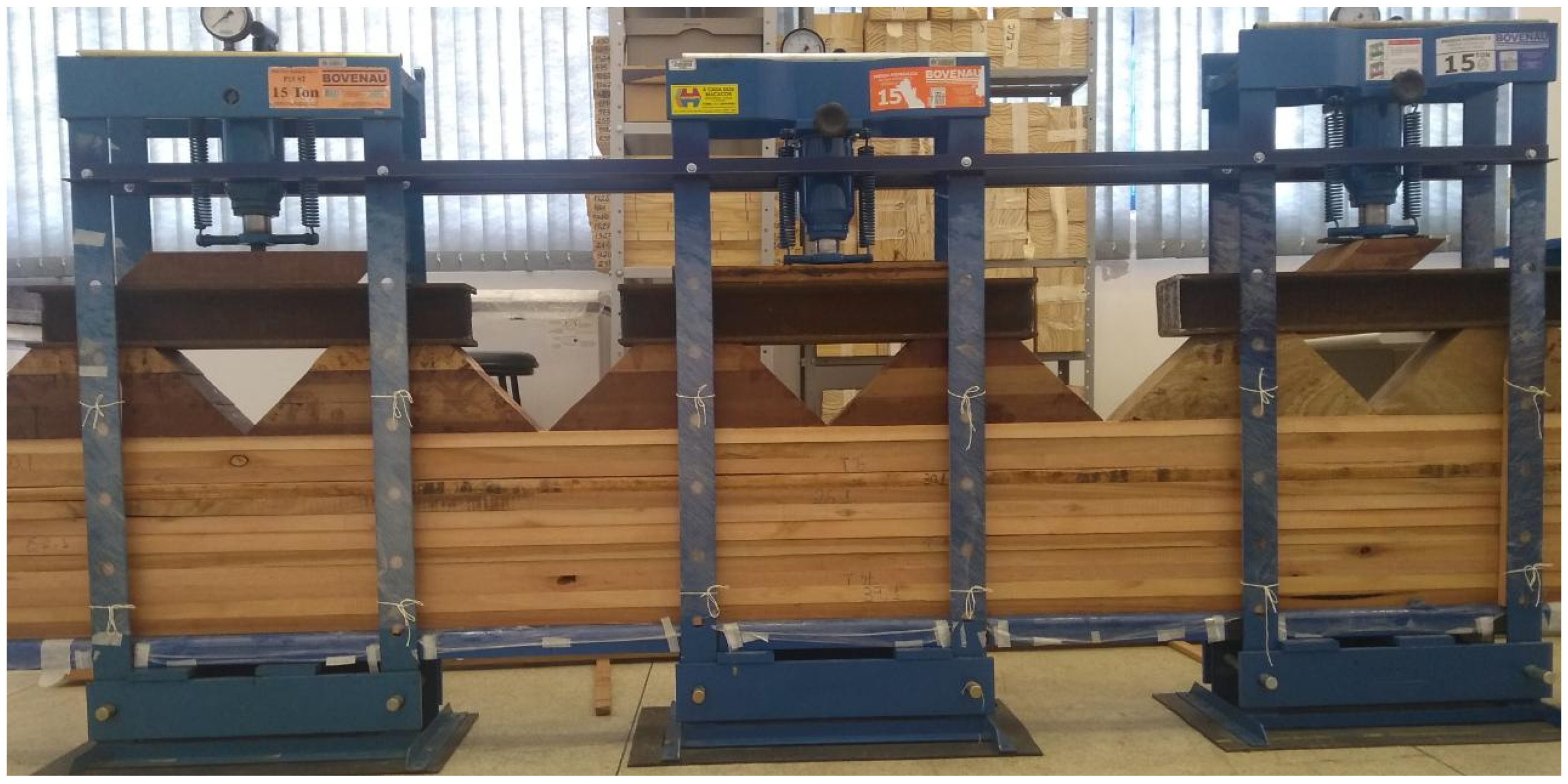
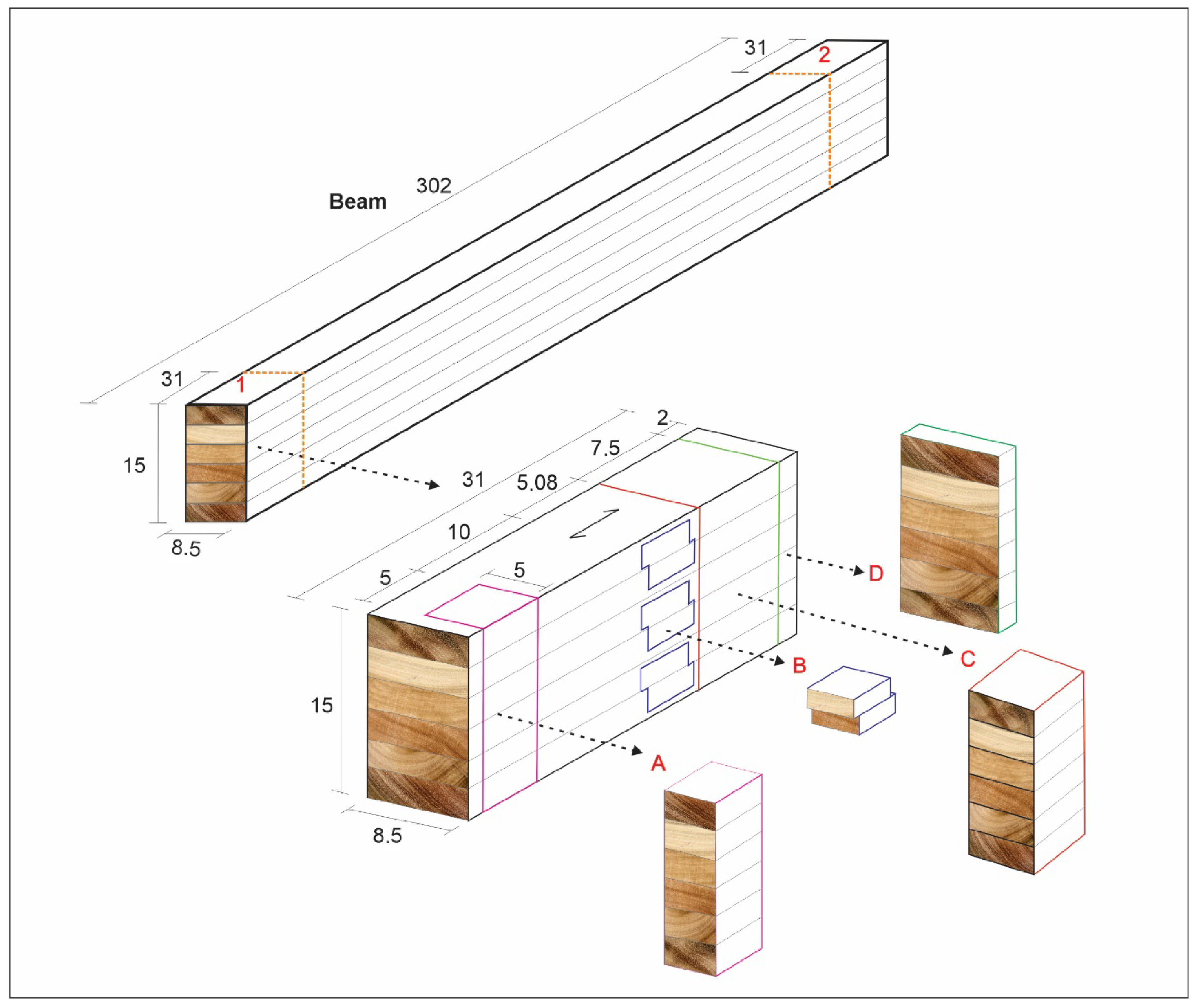
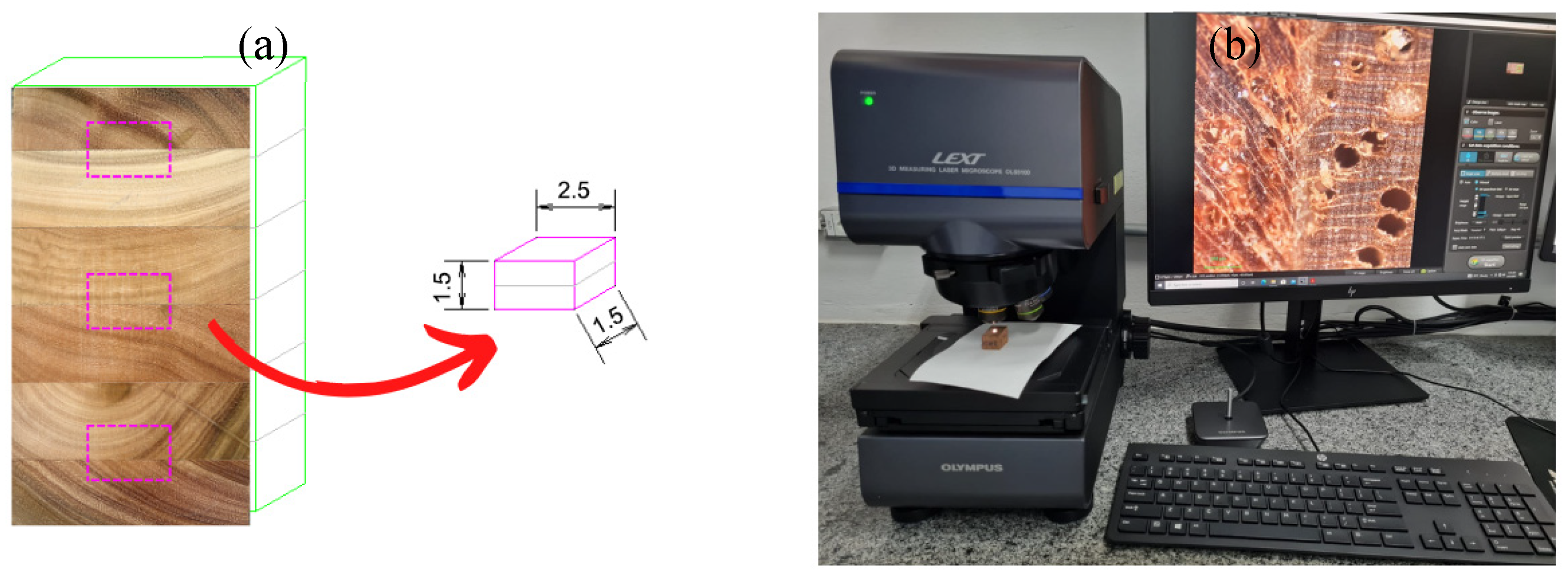
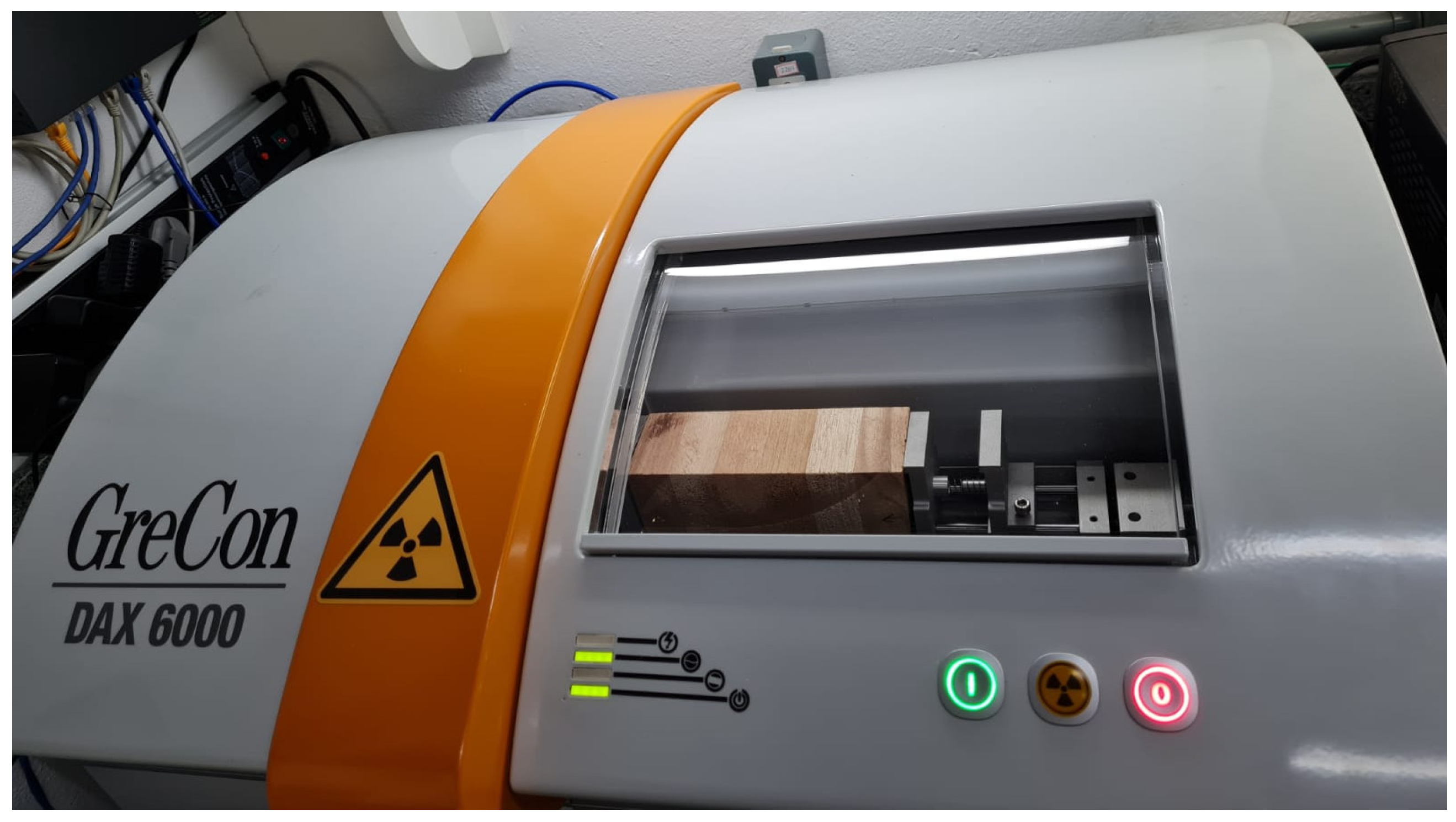
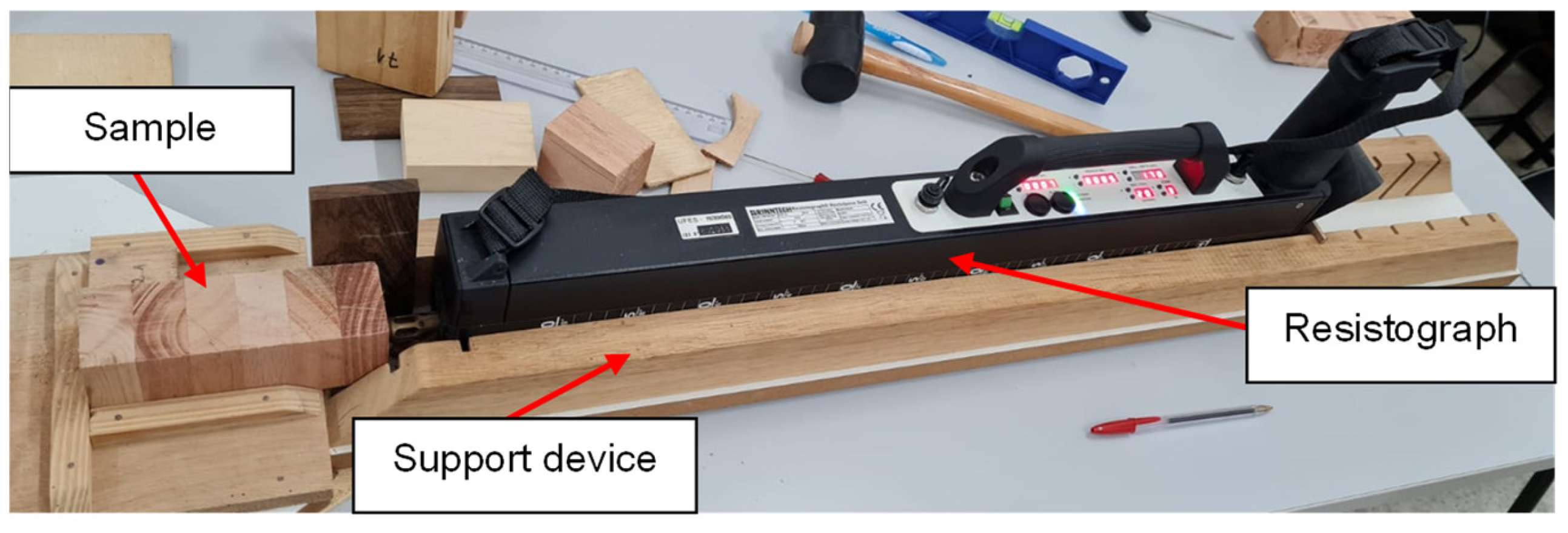

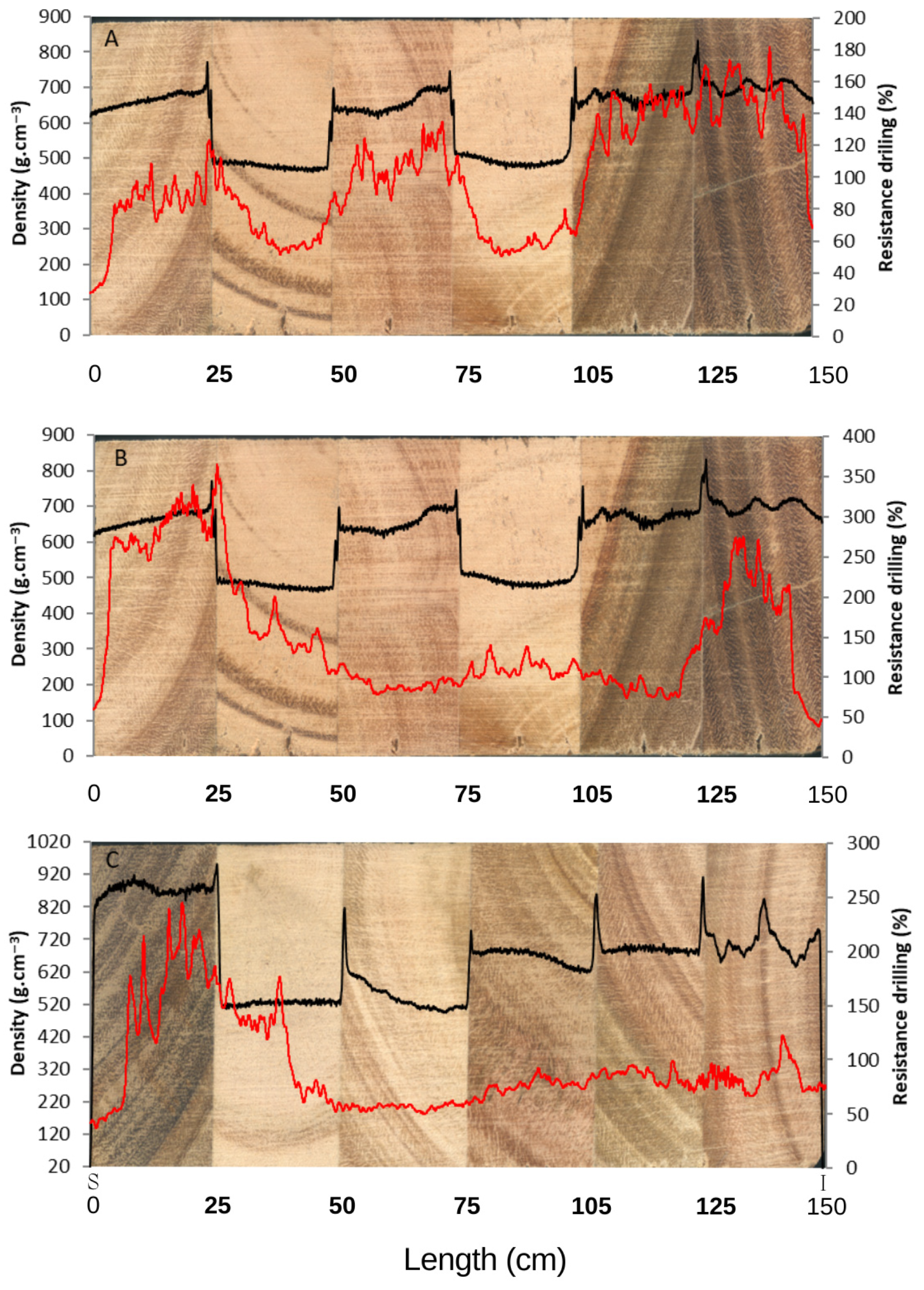
| Adhesive | Properties | ||||
|---|---|---|---|---|---|
| pH | Viscosity (cP) | Density (g.cm−3) | Solids Content (%) | ||
| PUR | Component A | 6.35 | 404.96 | 1.46 | 90.77 |
| Component B | 6.50 | 475.47 | 1.29 | 97.38 | |
| RF | 7.25 | 508.24 | 1.31 | 62.52 | |
| MUF | 9.05 | 1169.00 | 1.67 | 63.97 | |
| Dry Condition | |||
|---|---|---|---|
| Adhesive | fv0,m (MPa) | Wood Failure (%) | Moisture (%) |
| PUR | 11.50 a * (2.68) *** | 95.20 a (6.80) | 10.79 |
| RF | 11.70 a (3.22) | 84.90 a (9.10) | 10.56 |
| MUF | 9.38 a (1.88) | 69.90 b (27.41) | 10.41 |
| Saturated Condition | |||
| Adhesive ** | fv0,m (MPa) | Wood Failure (%) | Moisture (%) |
| PUR | 5.88 a (1.72) | 62.80 a (31.63) | 98.62 |
| RF | 6.04 a (2.19) | 76.00 a (25.75) | 92.73 |
| MUF | 5.78 a (2.53) | 73.60 a (29.19) | 97.34 |
| Adhesive | Delamination (%) | Minimum (%) | Maximum (%) |
|---|---|---|---|
| PUR | 16.3 a * | 6.69 | 25.61 |
| RF | 2.57 b | 0.00 | 6.98 |
| MUF | 12.2 a | 0.91 | 27.18 |
| Treatment | Apparent Density (g.cm−3) | Perforation Resistance (%) | ||
|---|---|---|---|---|
| Min | Max | Mean * | Mean * | |
| PUR | 0.04 | 1.03 | 0.624 a | 103.40 a |
| RF | 0.22 | 1.23 | 0.678 b | 115.20 b |
| MUF | 0.28 | 1.11 | 0.672 b | 115.44 b |
Disclaimer/Publisher’s Note: The statements, opinions and data contained in all publications are solely those of the individual author(s) and contributor(s) and not of MDPI and/or the editor(s). MDPI and/or the editor(s) disclaim responsibility for any injury to people or property resulting from any ideas, methods, instructions or products referred to in the content. |
© 2025 by the authors. Licensee MDPI, Basel, Switzerland. This article is an open access article distributed under the terms and conditions of the Creative Commons Attribution (CC BY) license (https://creativecommons.org/licenses/by/4.0/).
Share and Cite
Mastela, L.d.C.; Segundinho, P.G.d.A.; Gonçalves, F.G.; de Souza, C.G.F.; Lahr, F.A.R.; Minini, D.; Oliveira, M.P.; Belumat, M.A.R.; Araujo, C.P.d. The Application of Structural Adhesives in Glulam Beams: A Comparative Study. Forests 2025, 16, 1421. https://doi.org/10.3390/f16091421
Mastela LdC, Segundinho PGdA, Gonçalves FG, de Souza CGF, Lahr FAR, Minini D, Oliveira MP, Belumat MAR, Araujo CPd. The Application of Structural Adhesives in Glulam Beams: A Comparative Study. Forests. 2025; 16(9):1421. https://doi.org/10.3390/f16091421
Chicago/Turabian StyleMastela, Leonor da Cunha, Pedro Gutemberg de Alcântara Segundinho, Fabricio Gomes Gonçalves, Clara Gaspar Fossi de Souza, Francisco Antônio Rocco Lahr, Daniela Minini, Michel Picanço Oliveira, Maria Alice Romanha Belumat, and Caroline Palacio de Araujo. 2025. "The Application of Structural Adhesives in Glulam Beams: A Comparative Study" Forests 16, no. 9: 1421. https://doi.org/10.3390/f16091421
APA StyleMastela, L. d. C., Segundinho, P. G. d. A., Gonçalves, F. G., de Souza, C. G. F., Lahr, F. A. R., Minini, D., Oliveira, M. P., Belumat, M. A. R., & Araujo, C. P. d. (2025). The Application of Structural Adhesives in Glulam Beams: A Comparative Study. Forests, 16(9), 1421. https://doi.org/10.3390/f16091421







